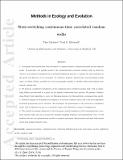Files in this item
State-switching continuous-time correlated random walks
Item metadata
| dc.contributor.author | Michelot, Théo | |
| dc.contributor.author | Blackwell, Paul G. | |
| dc.date.accessioned | 2020-02-14T00:35:06Z | |
| dc.date.available | 2020-02-14T00:35:06Z | |
| dc.date.issued | 2019-02-14 | |
| dc.identifier | 257793631 | |
| dc.identifier | 8547b27a-9dd4-4526-b605-b43220c97769 | |
| dc.identifier | 85061594679 | |
| dc.identifier.citation | Michelot , T & Blackwell , P G 2019 , ' State-switching continuous-time correlated random walks ' , Methods in Ecology and Evolution , vol. Early View . https://doi.org/10.1111/2041-210X.13154 | en |
| dc.identifier.issn | 2041-210X | |
| dc.identifier.other | RIS: urn:664E987A52CD74519B8116A89189F335 | |
| dc.identifier.uri | https://hdl.handle.net/10023/19461 | |
| dc.description | TM was supported by the Centre for Advanced Biological Modelling at the University of Sheffield, funded by the Leverhulme Trust, award number DS-2014-081. The grey seal telemetry data were provided by the Sea Mammal Research Unit (SMRU), University of St Andrews; their collection was conducted under UK Home Office Licence (60/3303) and supported by funding from the Natural Environment Research Council to SMRU. | en |
| dc.description.abstract | 1.Continuous‐time models have been developed to capture features of animal movement across temporal scales. In particular, one popular model is the continuous‐time correlated random walk, in which the velocity of an animal is formulated as an Ornstein‐Uhlenbeck process, to capture the autocorrelation in the speed and direction of its movement. In telemetry analyses, discrete‐time state‐switching models (such as hidden Markov models) have been increasingly popular to identify behavioural phases from animal tracking data. 2.We propose a multistate formulation of the continuous‐time correlated random walk, with an underlying Markov process used as a proxy for the animal's behavioural state process. We present a Markov chain Monte Carlo algorithm to carry out Bayesian inference for this multistate continuous‐time model. 3.Posterior samples of the hidden state sequence, of the state transition rates, and of the state‐dependent movement parameters can be obtained. We investigate the performance of the method in a simulation study, and we illustrate its use in a case study of grey seal (Halichoerus grypus) tracking data. 4.The method we present makes use of the state‐space model formulation of the continuous‐time correlated random walk, and can accommodate irregular sampling frequency and measurement error. It will facilitate the use of continuous‐time models to estimate movement characteristics and infer behavioural states from animal telemetry data. | |
| dc.format.extent | 1126417 | |
| dc.language.iso | eng | |
| dc.relation.ispartof | Methods in Ecology and Evolution | en |
| dc.subject | Animal movement | en |
| dc.subject | Continuous time | en |
| dc.subject | Multistate model | en |
| dc.subject | Ornstein–Uhlenbeck process | en |
| dc.subject | Random walk | en |
| dc.subject | State-space model | en |
| dc.subject | QH301 Biology | en |
| dc.subject | QA Mathematics | en |
| dc.subject | DAS | en |
| dc.subject.lcc | QH301 | en |
| dc.subject.lcc | QA | en |
| dc.title | State-switching continuous-time correlated random walks | en |
| dc.type | Journal article | en |
| dc.contributor.sponsor | NERC | en |
| dc.contributor.institution | University of St Andrews. Statistics | en |
| dc.identifier.doi | 10.1111/2041-210X.13154 | |
| dc.description.status | Peer reviewed | en |
| dc.date.embargoedUntil | 2020-02-14 | |
| dc.identifier.grantnumber | Agreement R8-H12-86 | en |
This item appears in the following Collection(s)
Items in the St Andrews Research Repository are protected by copyright, with all rights reserved, unless otherwise indicated.

